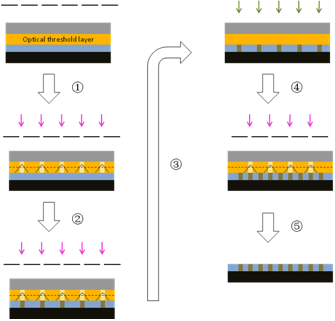Optical Threshold Layer
Optical threshold layer is one of the proposed approaches to Double Exposure Lithography. The main ideal is shown in the following figures.
The grey part represents a small molecule which can react with the resist (blue part) and forms a high etch resistance compound. The compound with high etch resistance will be the final image. The optical threshold layer is coated between the previous two materials.
In step one, the film stack is exposed under UV which causes the photochemistry in the optical threshold layer. The photochemistry changes the permeability of the middle layer. Only above certain amount of exposure does the OTL increase its permeability. The high permeability parts act as a diffusion channel, allowing small molecules go through.
In step two, the molecules in the top layer is able diffuse through the diffusion channel and react with the materials in the bottom layer, forming a polymer with high etch resistance. So far, the first exposure has been done.
In step three, the film stack is allowed to be exposed under another wavelength of light in order to reverse back.
In step four, the second mask is used for the exposure. The process is as same as the first one.
In step five, the top two layers are stripped. The bottom layer with the reacted resist is the final image.
The DEL process with OPT materials only introduces an additional exposure pass, and since the wafer is not removed from the imaging tool between exposures, the overlay issues are minimized.
Continue reading >> Material Design

